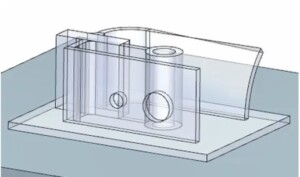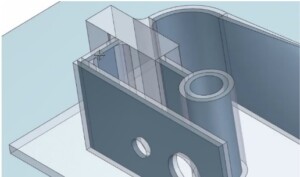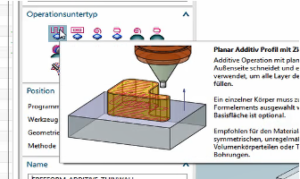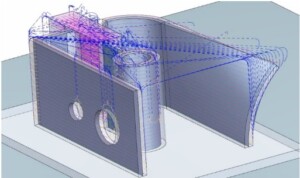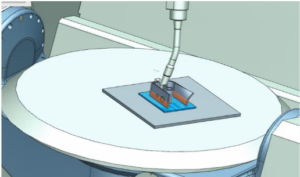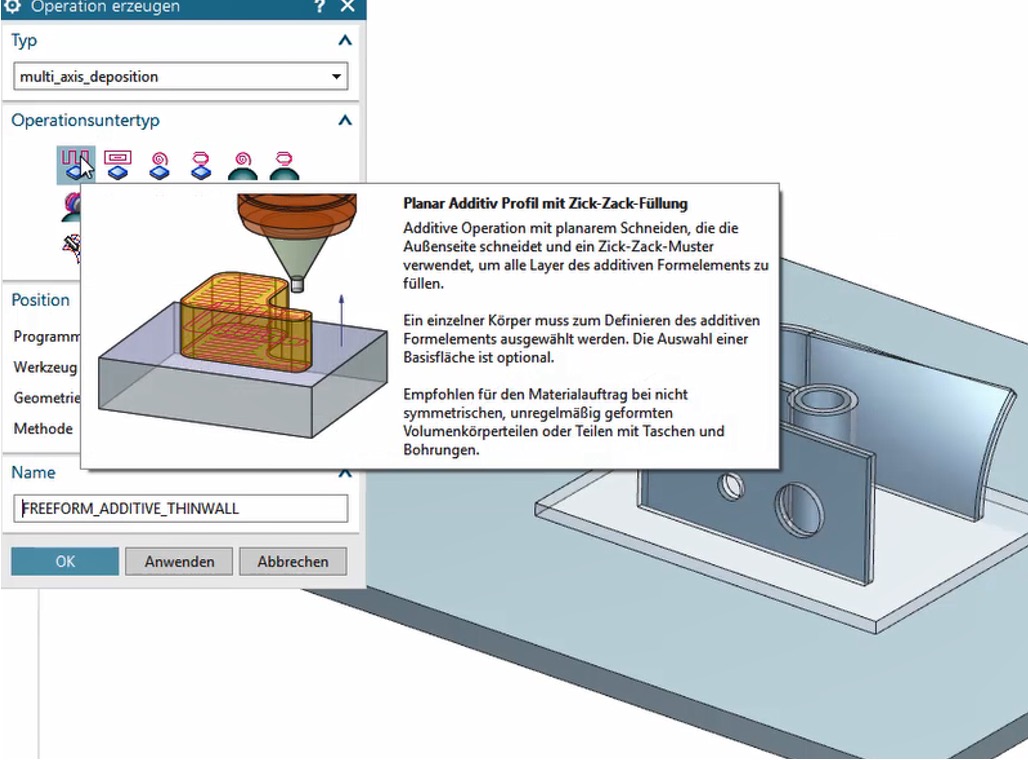DED Digital Process Chain
DED Digital Process Chain
CAD, CAM and CNC Control Software
The DED process chain spans the complete digital workflow—starting from CAD modeling and data preparation to tool path generation, AM build execution, and final machining. Each step plays a critical role in achieving part quality and process reliability. This section focuses on the digital backbone of DED manufacturing and how different software tools, strategies, and systems interact to enable industrial-grade production.
You will explore how CAD, CAM, and CNC control software work together to translate design intent into machine motion, including the challenges of 5-axis control, geometry adaptation, and real-world process tuning.
What you will learn in this section
Explore the Digital Workflow
Understand how DED parts are produced—starting with 3D modeling and ending with final machining.
Learn How Tool Paths Are Generated
See how CAM software creates motion paths, and why simulation and collision checks are essential for complex parts.
Compare Software Strategies and Challenges
Discover the differences between open, white-label, and proprietary software—including their benefits and limitations for real-world DED applications.
What you will find in this section
DED Process Chain
From Digital Model to Final Part
The DED process chain spans from digital data preparation to additive build and final machining. Each step—designing the part, generating tool paths, printing layer by layer, and refining geometry—plays a critical role in achieving high-quality components. This section focuses on the digital workflow of the DED process chain, focusing on data preparation and the AM build process.
Data Preparation
Data Preparation
- Creation of 3D CAD geometry
- G-Code based tool path programming (CAM software)
- Collision check for AM and machining process
AM Build Process
AM Build Process
- Additive manufacturing of part geometry
- Depending on part geometry
- > 5-axis manipulation may be necessary
Machining to Final Part
Machining to Final Part
- Recovery of manufactured geometry
- G-Code based toolpath programming (CAM software)
- Machining to final geometry
Digital Process Chain of data preparation
Transforming Design into Motion: The Digital Backbone of DED Manufacturing
The DED process workflow begins with CAD software, where the 3D part geometry is created and manipulated. This step includes tasks such as creating offsets, simplifying complex features, and filling holes to prepare the model for manufacturing. Once the design is finalized, the geometry is exported in a compatible format, depending on the CAD-CAM software used, ensuring seamless integration into the next step of the process.
The second step involves CAM software, which is used to generate tool paths and CNC programs, typically in G-code, to describe the motion and operations of the DED system. The specific software and coding requirements depend on the type of handling system, such as a robotic arm, portal system, or machine tool. The programming effort can vary significantly based on the capabilities and support provided by the CAM software, which directly impacts the efficiency of the tool path generation process.
Finally, the CNC control software interprets the G-code and controls the DED hardware during operation. This software ensures the accurate execution of the programmed tool paths and may interface with additional control systems, such as triggering the laser source and powder feeder. Precise coordination of these systems is critical for producing high-quality parts, making this final step essential for successful DED process execution.
Creation of 3D part geometry
- Creation of 3D CAD geometry
- Manipulation of original part geometry
- Creation of offsets, simplification of features, filling of holes, …
- Export of geometry, depending on used CAD-CAM software
Creation of tool paths via G-code
- Creation of CNC program
- Use of CAM software to create G-code for tool path description
- Used software and code depending on handling system and manufacturer (machine tool, robot, portal system, …)
- Programming effort strongly depend on software support/capabilities
Interpretation of G-code and control of hardware
- Machine control running of defined program
- Possibly interfaces to additional control systems necessary, e.g. trigger of laser source and wire feeder
Computer Aided Manufacturing (CAM)
Generating the tool paths and CNC program to build the geometries forms the key step of the data preparation phase. It consists of the following 5 steps:
Dividing part geometry & Creating center planes
The process begins with selecting the manufacturing system. A predefined machine body and axis configuration are chosen to suit the specific part requirements. This ensures that the chosen system can effectively handle the part geometry and manufacturing process.
Once the system is selected, the part geometry is imported into the CAM module. This step integrates the 3D model into the software environment, enabling further manipulation and preparation for manufacturing.
The next step involves the definition of the AM part and base plate geometry. This is where the shapes and dimensions of the part and its supporting structures are precisely determined, ensuring stability during the manufacturing process.
The dividing of part geometry into features follows, where specific sections such as thin walls, cylinders, or voluminous areas are identified. This segmentation is essential to optimize the manufacturing approach for each unique feature.
Finally, center planes are created for wall features, allowing for efficient programming. These center planes enable either single-path or multi-path strategies with offset programming, ensuring precise and controlled material deposition for complex wall structures.

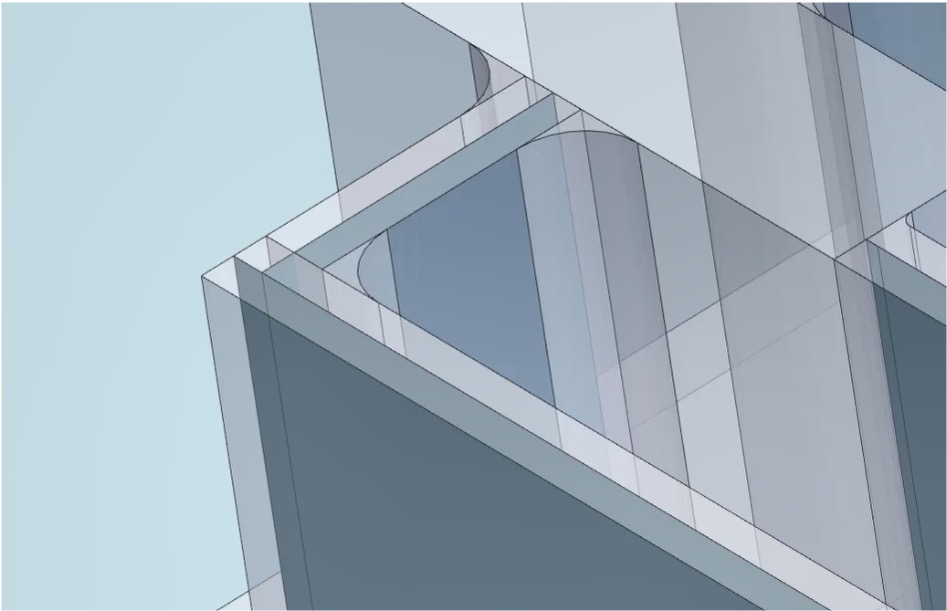
Dividing part geometry & creating center planes in Siemens NX
Defining tool path for geometrical features
The tool path for weld bead application is programmed in G-Code, which serves as the instruction set for the manufacturing system. The complexity of this programming step can vary significantly depending on the specific system and the level of user support provided by the software.
In some cases, users may need to manually program each individual path, requiring meticulous attention to detail and extensive time investment. However, advanced software solutions, such as Siemens NX, offer predefined tool path strategies tailored to different geometrical features. This feature streamlines the programming process and reduces the potential for errors.
To successfully create the underlying process data, deep knowledge of the DED process is essential. This includes understanding the interactions between material, energy, and tool path strategies, ensuring high-quality weld bead application and optimal part performance.

Defining tool path for geometrical features in Siemens NX
Modern manufacturing systems and CAM software offer predefined tool path strategies designed for different surface geometries. For flat surfaces and voluminous features, a zig-zag path strategy is typically applied to ensure efficient material deposition. For thinner features, a single-path strategy provides greater precision and control.
When working with complexly curved base materials, specialized strategies are employed to align the tool path with the curvature of the part. This is particularly relevant for geometries like curved tubes, where varying layer thickness must be accounted for during programming.
However, achieving accurate alignment between the programmed tool path and the manufacturing result requires a well-established and stable process. For geometries with varying layer heights, such as curved tubes, the challenge increases due to the complexity of maintaining consistent material deposition. A thorough understanding of the process and its limitations is essential to ensure high-quality outcomes.
Simulating toolpaths and collission checks
Simulation of toolpaths in Siemens NX
The simulation of tool paths is a critical step in the manufacturing workflow, ensuring the plausibility and proper sequencing of the programmed tool paths. This step allows for the visualization of the deposition process, enabling the identification of potential issues before production begins.
A key aspect of simulation is the collision check, particularly in systems involving 5-axis part and tool manipulation. With the added complexity of multiple axes, the risk of collisions between the tool, part, and machine components increases. Simulation ensures that the tool paths are free of such conflicts, safeguarding both the equipment and the workpiece.
By performing these simulations, manufacturers can optimize the process, reduce errors, and ensure a smooth transition from programming to actual production.
Main challenges of the digital process chain
Challenges in toolpath generation and process-control remain
Even with advanced digital tools, DED manufacturing still faces critical challenges in toolpath generation, parameter adaptation, and in-process control. These limitations often demand expert intervention, careful calibration, and proprietary machine know-how—especially when dealing with complex geometries, varying wall thicknesses, or evolving sensor systems.
Click on the headlines below to reveal more details on the respecitve challenge.
1. Toolpath Generation
Up until today there is no real automated solution for complex part geometries requiring 5-axis programming results in substantial pre-processing efforts. AM-focused tools offer simplified paths based on reference geometries. In any case, expert knowledge still needed for strategy selection. In general, there are three types of software available for toolpath generation.
Independent from solution, selection of the optimal tool path is predominantly based on user experience. Selecting a proprietary solution can increase experience transfer and application development support from vendor.
3rd party solution
- Multiple CAD/CAM solutions have specialized on Additive Manufacturing
- Traditional CAD/CAM suppliers (e.g. Siemens) focus on an integrated software chain from CAD file to finished parts incl. digital twin
- AM focused solution supplier (e.g. Adaxis, aibuild) address DED specific advanced path planning
- Missing experience and feedback from part manufacturing may hinders creation and suggestion of optimized paths


Proprietary
- Inclusion of process expertise from machine OEM regarding optimized tool path strategies
- Highest degree of development support. Customizable to specific application and customer need
- Possibly, limited software development resources at machine OEM
- Possibly, limited compatibility with customer chosen power sources and handling systems in individual integrator set-ups

2. Adapted Build Parameters
To achieve optimal part quality in DED, adapted process parameters must be applied locally—particularly in complex regions such as intersections or when transitioning between thin and thick wall sections. Several machine OEMs, including WAAM3D and MX3D, are actively developing parameter datasets for common part features. However, the availability of such advanced, pre-qualified datasets remains limited.
Users who adopt self-built systems or purchase from integrators without deep DED expertise often face a steep and time-consuming learning curve, particularly in developing their own parameter sets.
While adaptive parameter control is currently essential for producing high-quality parts with varying geometries, feasible in-process control systems that could automate this adjustment are still in early stages of development.
3. In-Process Control
DED systems increasingly integrate sensors such as thermal cameras, pyrometers, and melt-pool imaging to monitor build quality. However, most machines still rely on basic control logic, such as temperature-based weld starts, without real-time process adjustments.
Advanced in-process control—like closed-loop energy management or adaptive layer height correction—is under development but not yet widely available. It’s important to distinguish between passive monitoring and active control, as the two are often confused in vendor communication.
Most systems today monitor the process—but true, automated control is still in its early stages.

